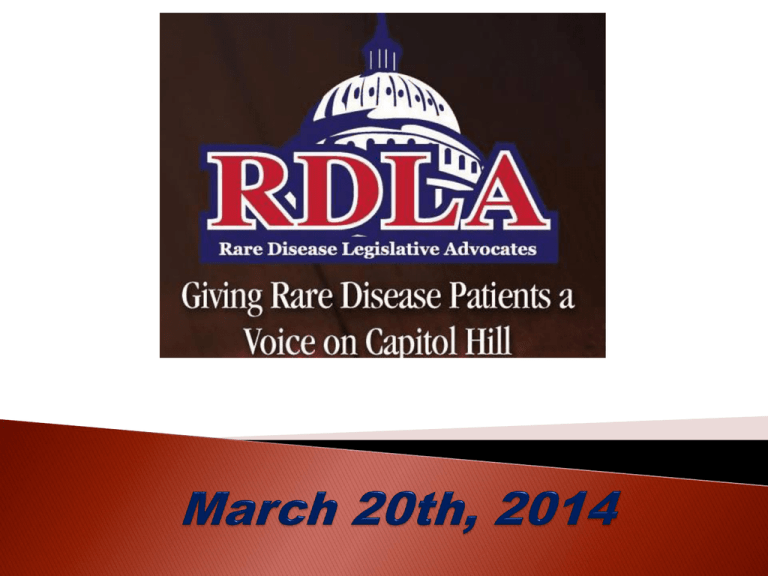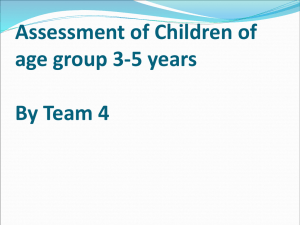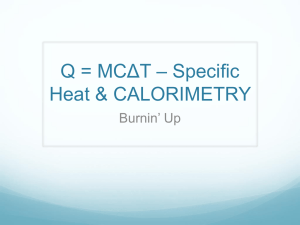RDLA March 2014 - Rare Disease Legislative Advocates
advertisement

Potential elimination of the Orphan Drug Tax Credit - Joel White & Jill Schmalz, Horizon Government Affairs Community efforts to encourage CMS to revise its proposed rule on Medicaid “line extension” rebates – Jennifer Bernstein, Horizon Government Affairs Preserving Access to Orphan Drugs Act of 2013 - Theo Merkel, Office of Senator Pat Toomey American Cures Act (America Helping Encourage Advancements in Lifesaving Science) - Dr. Binta Beard, Office of Senator Richard Durbin The Patients Choice Act - Karen Jaffe, Fight to Live Newborn Screening Saves Lives Act Re-authorization - Emil Wigode, March of Dimes Patients' Access to Treatment Act - Emily Shetty, The Leukemia & Lymphoma Society CAL Undiagnosed Diseases Research and Collaboration Network Act - Taylor Gilliam, Office of Representative John Carter Tax Reform Discussion Draft: What Does it Mean for Rare Diseases and Orphan Drugs? Joel White, Jen Bernstein and Jill Schmalz Horizon Government Affairs March 20, 2014 S Tax Reform: Background S Representative Dave Camp (R-MI), Chairman of the Committee on Ways and Means, released a tax reform discussion draft for comment on February 26, 2014 S Goals: S economic growth: S job creation: GDP by $3.4 trillion 1.8 million new private sector jobs S simpler and fairer tax code: 95% of filers in lowest rate Tax Reform: Basics S New Individual and Corporate Rate Structure: S S S S S Larger Standard Deduction: S S Reduces rates and collapses brackets into two: 10 and 25 percent for virtually all taxable income No Alternative Minimum Tax Reduces the corporate rate to 25 percent More than 99 percent of all taxpayers face maximum rates of 25 percent or less Increases and inflation adjusts the standard deduction of $11,000 for individuals and $22,000 for married couples Charitable donations: S S S Expands deductible contributions past the end of the tax year Simplifies exempt organization taxes and sets a floor instead of a cap to the amount of donations that can be deducted Committee estimates an addition $2.2 billion in charitable contributions annually Tax Reform: Process S Goal is to simplify the tax code by eliminating most credits and deductions to get rates as low as possible S Blank slate assumed no credits or deductions S The Committee then reviewed every credit and deduction and made decision about which to keep and which to repeal S Repeals the Orphan Drug Tax Credit S Reforms and Makes Permanent the R&D Tax Credit Orphan Drug Credit S Current law provides a 50 percent business tax credit for qualified clinical testing expenses for rare diseases or conditions S S Qualified clinical testing expenses are costs incurred to test an orphan drug after it is approved by the FDA for human clinical trials, but before the drug has been approved for sale A rare disease or condition is defined as one that (1) affects less than 200,000 persons in the United States, or (2) affects more than 200,000 persons, but for which there is no reasonable expectation that businesses could recoup the costs of developing a drug for such disease or condition from sales in the United States of the drug S The discussion draft repeals the credit for amounts paid or incurred in taxable years beginning after 12/31/2014 S Under current law, expenses incurred for clinical testing expenses for orphan drugs or rare diseases or conditions are ineligible for the general research credit S Under the discussion draft, research on orphan drugs or rare diseases can claim this credit Research and Development Tax Credit S Credit expired on 12/31/13. S R&D credit is 20 percent of amount of expenses that exceed a base year OR an alternative credit of 14 percent calculated on a different base S The proposal makes the alternative method for calculating the R&D credit permanent as of 12/31/13, increases the rate to 15 percent, and repeals the 20 percent calculation method S The permanent general research credit is equal to: S S 15 percent of the qualified research expenses for the tax year that exceed 50 percent of the average qualified research expenses for the three preceding tax years Committee staff indicated that while the credit rate is less than the Orphan Credit, the base used in calculating the credit is larger, so the tax benefit may be more. Staff is soliciting analysis from impacted entities Committee’s Next Steps S Committee leadership is meeting with Members of Congress to discuss the draft and receive feedback S Committee members and staff are soliciting feedback from groups on all aspects of the discussion draft S The Committee intends to hold hearings on the discussion draft and then will decide how to proceed S Committee staff has asked for our input on the Orphan, R&D and TPTC Our Next Steps S Financial impact analysis on how repeal of the credit but increase in R&D credit washes out: S Positive: more incentive to conduct research into rare diseases S Neutral: same incentives S Negative: less incentive to conduct research into rare diseases S Develop advocacy materials, including letter to Chairman Camp S Meet with Committee Staff S Hill Briefing on May 7 Questions and Discussion Thank You Joel White President jwhite@horizondc.com (202) 559-0192 Jen Bernstein Executive Vice President jbernstein@horizondc.com (202) 559-0197 Jill Schmalz Senior Vice President jschmalz@horizondc.com (202) 803-6031 BACKGROUND: ◦ The Patient Protection and Affordable Care Act subjects some orphan drugs to a new fee on branded prescription drugs. ◦ Drafters conditioned exemption from the new fee to a manufacturers’ utilization of the Orphan Drug Tax Credit, leaving some orphan drugs still subject to the fee. LEGISLATION: Would exclude ALL pharmaceuticals indicated by the Food and Drug Administration solely for the treatment of a rare disease from the branded prescription drug fee imposed under the Patient Protection and Affordable Care Act. STATUS: Senate – S. 1128 ◦ Introduced by Senator Pat Toomey (R-PA) with 5 bipartisan cosponsors. House – H.R. 2315 ◦ Introduced by Representative Jim Gerlach (R-PA-6) with 39 bipartisan cosponsors. Federal investment in biomedical research has generated medical discoveries and scientific innovations that have led to longer lives, created new industries, and established the U.S. as a leader in research and development. But years of stagnant federal investment in biomedical research jeopardize future life-saving discoveries and our standing as a global leader in research. The American Cures Act proposes to augment federal appropriations for biomedical research with a mandatory trust fund dedicated to steady growth in federally funded biomedical research. Stagnant Investment in Biomedical Research ◦ This graph illustrates the decline in biomedical research in constant dollars from 2004-2014. 35 Federal Funding for NIH, CDC, VA Research, and DHP in Constant Dollars 34 33 32 31 30 29 28 27 26 25 2004 2005 2006 2007 2008 2009 2010 2011 2012 2013 2014 The bill creates a trust fund to support a mandatory funding stream. That funding will be available to the Appropriations Committee to supplement discretionary appropriations for the following agencies and programs, which represent the core drivers of federally funded biomedical research in the U.S.: ◦ ◦ ◦ ◦ National Institutes of Health (NIH) Centers for Disease Control and Prevention (CDC) Department of Defense Health Program (DHP) Veterans Medical & Prosthetics Research Program The mandatory funding is dependent on appropriation levels at or above FY14 levels, ensuring that the American Cures Act does not supplant discretionary spending for the eligible programs Estimated Cost Each year, the bill would increase funding for each agency and program at a rate of GDPindexed inflation plus 5%. This steady, long-term investment allows the agencies to plan and manage strategic growth while maximizing efficiencies. Based on projections from the Congressional Budget Office, investment at this pace will require an additional $150 billion over 10 years. Patient Choice Act ….for those you love Basic Elements • FDA provisional approval of fast track drug after establishment of Safety • Full approval continues to be sought • Distribution under informed consent • Enables provisional approval of drugs on the market in approved countries for > 4 yrs • Solves the Compassionate Use Problem!! Benefits • Provides patient rights to early access to investigational therapies under informed consent – giving patients the right to choose their therapies. • Can save thousands of patients’ lives every year who die waiting for FDA approved access to therapies, when all the standard approved therapies run out. • Preserves the existing regulatory system while making it financially viable for the companies. • Promotes innovation and ensures medical advances can reach the marketplace more quickly. • Stops the loss of companies investing in the development of therapies for deadly & rare diseases, and creates jobs, growth and drives American leadership in medical innovation. Calls for Provisional Approval • • • • • • Manhattan Institute Milken Institute Kauffman Foundation PCAST NEWDIGS And many more! • “Such a reform would allow drugs that have been found safe and promising (in Phase I and Phase II clinical trials) to win approval for limited marketing to patients. This would give patients early access to innovative new therapies, while the FDA would retain the ability to collect information confirming the drugs’ safety and effectiveness and to revoke a drug’s marketing authorization later, when appropriate.” Manhattan Institute Legislative Status • Introduced in 113th congress on May 22nd • Many support letters – ALWAYS NEED MORE!! • Lead by Cong. Morgan Griffith (R-VA), Cong. Peters (D-CA), Cong. McCaul (RTX),T. Yoho (R-FLA) Under many private insurance plans, patients with cancer continue to pay extremely high out-of-pocket costs because their prescribed medication is often placed on a “specialty tier.” Specialty tiers allow plans to impose high coinsurance, in lieu of a co-payment, for expensive drugs, resulting in higher out-of-pocket spending for patients. Not only does this place a financial burden on patients, but it has also been shown to discourage adherence to treatment which can increase overall costs to the healthcare system. HR 460, the Patients Access to Treatments Act, a bill which would require plans to limit cost-sharing requirements for specialty drug tiers to the level of cost sharing required for non-preferred brand drug tiers. An independent study revealed that H.R. 460 would have a negligible impact on insurance premiums, increasing premium costs by $3 per year, absent any other changes to the average benefit design. This change would only impact 14 percent of commercial health plans, leading to less than 0.01 percent increase in the average commercial insurance health plan, for better coverage of treatments used to treat chronic and lifethreatening conditions Brief Background on Cal: In 2006, a young boy by the name of Cal passed away when he was five years due to an undiagnosed disease. During his short life, Cal developed many unexplained medical problems such as neurological difficulties, cerebral atrophy, migraines, and seizures. Doctors handling Cal’s case could only tell his parents what diseases he did not have, and tragically Cal’s parents never received a confirmed diagnosis. If there had been a medical database, where symptoms of rare diseases could be shared; doctors could have collaborated on Cal’s case and confirmed a diagnosis. Currently, there is no database like this that is available, and the only way to compare cases is by word of mouth. Facts about Undiagnosed Diseases: According to the Department of Health and Human, undiagnosed diseases are considered to be disorders with long-standing symptoms or signs that have not been diagnosed; despite extensive clinical investigation. Undiagnosed diseases include rare diseases that less than 200,000 individuals in the US have, yet-to-be-described disorders, or rare variants of more common diseases. According to the European Organization for Rare Disease, 25% of diagnoses are delayed between 5-30 years. This delay in an accurate diagnosis can be costly by involving numerous tests, medications, therapies, travel, and special diets. These expenses can leave the patients and loved ones emotionally and physically drained. The CAL Network: Ever since Cal’s untimely passing, Heather, Cal’s mother, has made it her mission in life to help create a rare disease database. This database would allow doctors to share patient symptoms and effectively collaborate with one another. Congressman John “Judge” Carter was inspired by Cal’s story and Sponsored H.R. 1591 the CAL Undiagnosed Diseases Act of 2013. H.R. 5191 outlines the CAL Network, in order for it to be successful. The CAL Network would provide physicians with a way to search for similar cases of undiagnosed diseases. The CAL Network: This network would help determine factors that contribute to undiagnosed diseases (i.e. age, race, gender, family history). This network would also help identify reason for misdiagnoses, and allow the Secretary of Health determine if additional undiagnosed disease programs are needed. The CAL Network would additionally be beneficial for veterans returning home. Currently, there is a long list of veterans with undiagnosed diseases. Since, more and more veterans are returning home, this already long list could increase in number and ultimately be detrimental to our brave men and women. Implementation of CAL Network: The CAL Network implementation would require two critical phases. The first phase would be a study period. The study period would last up to one year after the date of enactment in order for any necessary study and research necessary to implement the CAL Network. The implementation phase would require the CAL Network to be up and running on September 30, 2015. The CAL Network Bill would authorize 5 million from the FY2014 to FY2019 appropriations to fund the CAL Network. April 23 - RDLA Luncheon, 750 9th Street, NW, Suite 750, Washington, DC • 20001 May 7th - Caucus Briefing, Rayburn House Office Building, Washington D.C.








